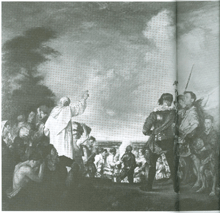Flight of the Earls: A Bridge Between Ireland and Europe

 ‘Flight of the Earls’ is the popular term for the departure of Hugh O’Neill, Earl of Tyrone, Rory O’Donnell, Earl of Tyrconnell, and their followers from Ireland in 1607. Still regarded as one of the pivotal episodes in Irish history, the period before and after has left its mark on language, literature, religion, politics and the very genetic make-up of the island of Ireland.
‘Flight of the Earls’ is the popular term for the departure of Hugh O’Neill, Earl of Tyrone, Rory O’Donnell, Earl of Tyrconnell, and their followers from Ireland in 1607. Still regarded as one of the pivotal episodes in Irish history, the period before and after has left its mark on language, literature, religion, politics and the very genetic make-up of the island of Ireland.
Lough Swilly from which they sailed witnessed a key event - the end of the old Gaelic order - when from Portamurray Pier in the small fishing town of Rathmullan, Co. Donegal, at mid-day on 14 September 1607, a small ship with ninety-nine followers set sail for Spain. The chieftains who could not live with the new English order sought refuge with England’s main enemy with the hope either of making a new life for themselves or living to fight another day.
Women of the Flight
In comparison to women in most of early modern Europe, Irish women enjoyed a marked degree of independence from their husbands. They had, for example, rights of independent inheritance, education and freedom from physical abuse that were unique for women of their class.
Those who sailed from Lough Swilly hoped to return to establish the Gaelic way of life and perhaps women even more than their men folk had a strong interest in trying to make that happen. In fact women played an important role within the exile community and one of the exiles Rosa O’Doherty only seventeen at the time of the Flight returned to Ireland almost half a century later after the Royalist (and Irish) defeat in the Cromwellian wars.
“That foreign ship has three of our women of the nobles of the soil of Banba, the gentle ladies from Erin for whose loss all sorrowed”.
The three gentle ladies were: Catherine O’Neill who married Hugh O’Neill in 1598, Rosa O’Doherty and her infant son Hugh, Nuala O’Donnell, wife of Niall Garbh O’Donnell.
400th centenary (1607-2007)
To mark the quarter centenary, a series of major local, national and international conferences and lectures, exhibitions, social, cultural and school programmes have taken place at home and abroad. In part they have been financed by a special programme of the European Union.
In January 2007 a three-part series Flight of the Earls in English and Irish was shown on Northern Ireland BBC ONE and TWO. The series charts the Earls’ epic journey across Europe as they sought help of allies for a victorious return to Ireland. The series uses dramatic reconstructions of significant battles that led up to the Battle of Yellow Ford three miles north of Armagh (1598) and the Battle of Kinsale, Co. Cork (1601). The programmes also explore the reasons behind why the Earls made such a hasty departure from the shores of Lough Swilly in 1607 and reviews 400 year old documents and manuscripts that refer to the Gaelic leaders’ journey.
A Bridge between Ireland and Europe
In March 1608 the last of the Gaelic chieftains, their families and friends - over thirty persons in all, men and women, passed into Switzerland from the frontier at Basel on a journey across continental Europe which began in northern France and which eventually took them to Rome.
From Basel they travelled to Lucerne, across the lake, and upwards over the high ice-bound reaches of the St. Gotthard Pass, descending by sledge to the milder climate of Bellinzona and Lugano. When they eventually reached Milan, then under the control of Spanish allies, they were welcomed and feted with all protocol and hospitality.
The secret order of the day, however, was that they were to be encouraged to go to Rome, not Spain, and in Rome they eventually arrived on 29 April 1608, never to return to Ireland.
Switzerland (1608-2008)
On 17 March 1608, in a late winter storm the nobles lost a fortune in gold down a deep ravine near the famous ‘Devil’s Bridge’. The gold has never been found: chronicled as lost treasure of the St. Gotthard Pass!
There has been close cooperation between Ireland and Switzerland for commemorative events to be held around 17 March 2008. They include visits and exchanges between high level government and local officials with active participation in preparation of the programme by many Irish expatriates and Swiss nationals.
In 2008 the Swiss cities of Andermatt, Basel, Berne, Geneva, Lucerne, Lugano and Zurich will hold a series of social events, exhibitions, lectures, concerts and theatre performances for which many national institutions, organisations, corporations and individuals have provided support and goodwill. Notable is the professional Tony Award winning play by Brian Friel Making History about this watershed event in Irish history. It has been touring in Europe since 2005.
In Andermatt, at the heart of the Swiss Alps, at the medieval church dedicated to St. Columbanus, a memorial plaque will be unveiled by 1998 Nobel Peace Prize Laureate, John Hume, on St. Patrick’s Day 2008.
Ita Marguet, March 2008
Note: Acknowledgement is given to all sources used in preparation of this text, specifically on-line source Flight of the Earls: A Bridge Between Ireland and Europe (1607-2007). It follows a published article Flight of the Earls: Ireland and Switzerland (1607-1608) by Ita Marguet, January 2008.


